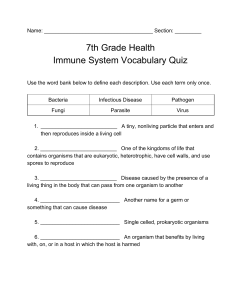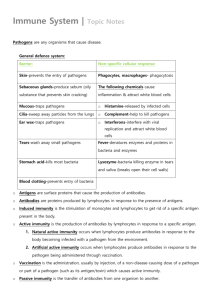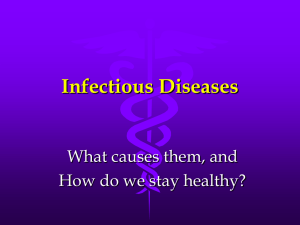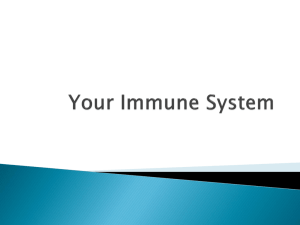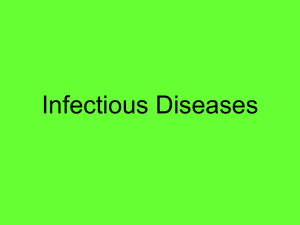37-Immunity
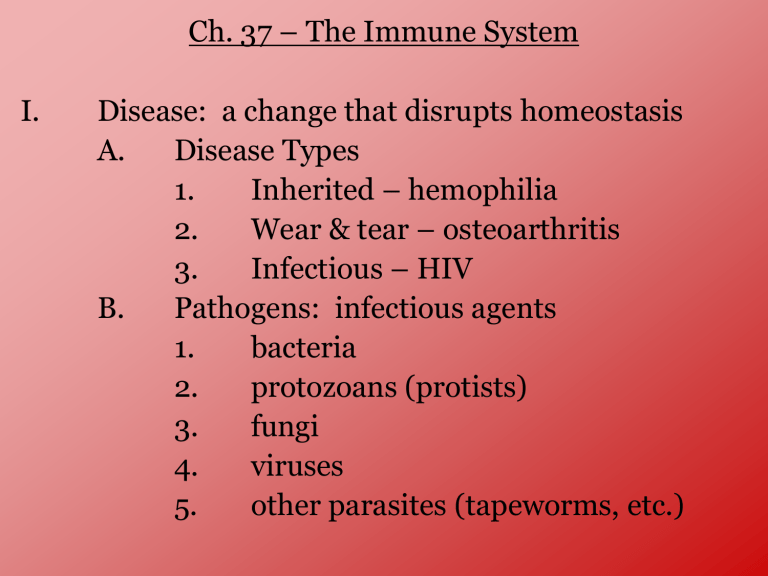
Ch. 37 – The Immune System
I.
Disease: a change that disrupts homeostasis
A.
Disease Types
1.
Inherited – hemophilia
2.
Wear & tear – osteoarthritis
3.
Infectious – HIV
B.
Pathogens: infectious agents
1.
bacteria
2.
protozoans (protists)
3.
fungi
4. viruses
5.
other parasites (tapeworms, etc.)
II.
Spread of Disease
A.
Reservoir – source of a pathogen
1.
Objects: soil, water, food
2.
animals (influenza, rabies, Lyme)
3.
people (carriers w/o symptoms)
▪ Typhoid Mary
TM video TM article
B.
Transmission – spreading a pathogen
1.
Direct Contact – skin contact
▪ cold, mono, influenza, STDs
2.
Indirectly by an Object – money, toys, lip gloss, pencils
3.
Indirectly through the Air – droplets of mucus are coughed or sneezed into air
4.
Intermediate organism called a VECTOR
▪ mosquito – malaria, West Nile virus
▪ tick – Lyme disease, Rocky Mountain spotted fever
▪ flea – bubonic plague
III. Disease Patterns
A.
Endemic – a disease that is always present in small amounts in a population (common cold)
B.
Epidemic – a disease that strikes people at the same time in the same area (flu season)
C.
Pandemic – a disease that spreads worldwide
(1918 flu, H5N1 Bird flu,
H1N1 Swine flu)
IV.
Treating & Fighting Diseases
A.
Antibiotic – a substance that kills or prevents growth of other microorganisms
(not viruses)
▪ Penicillin – a mold (fungus)
B.
Antibiotic Resistance – stronger bacteria from repeated antibiotic exposure are now difficult to kill (gonorrhea, MRSA)
V.
Nonspecific Immunity – you’re born with this
A.
Physical Barrier – unbroken skin covered w/ beneficial bacteria
B.
Chemical Barriers
Injury
1.
Saliva, tears, mucus, oil, & sweat contain lysozyme, which breaks down bacterial cell walls of some bacteria
2.
Hydrochloric acid (HCl) in the stomach kills pathogens on food
Histamine released
& blood vessels dilate
C.
Responses
1.
Inflammation – redness, pain, swelling, & heat
(caused by histamine) help destroy pathogens
2.
Phagocytosis – white blood cells called macrophages engulf and destroy pathogens
• Pus is the accumulation of wbc’s
3.
Interferons – proteins that protect cells from specific viruses
VI.
Specific Immunity – more effective, but it takes time to develop
A.
B-cells: WBCs called lymphocytes
1.
Our cells, along with pathogens, have antigens on their surfaces
2.
Pathogens are detected by the body because of their antigens
3.
B-cells produce antibodies to destroy foreign antigens
B.
Helper T-cells: help B-cells make more antibodies
C.
Cytotoxic T-cells: destroy pathogens
D.
Memory cells: long-living cells that respond rapidly if the body encounters the same pathogen later
E.
Passive Immunity – develops by getting antibodies made by another host
1.
Mother transfers her antibodies to baby through placenta or milk
2.
Antibodies can be injected from an animal or human who is already immune to the disease
hepatitis, rabies, snake venom
F.
Active Immunity – develops by being exposed to antigens & making antibodies from Memory cells
1.
Chicken Pox
PARTIES!
2.
Immunizations – vaccines provide deliberate exposure to a pathogen to make
Memory cells
Timeline of Diseases & Vaccines
Immune System Failure

